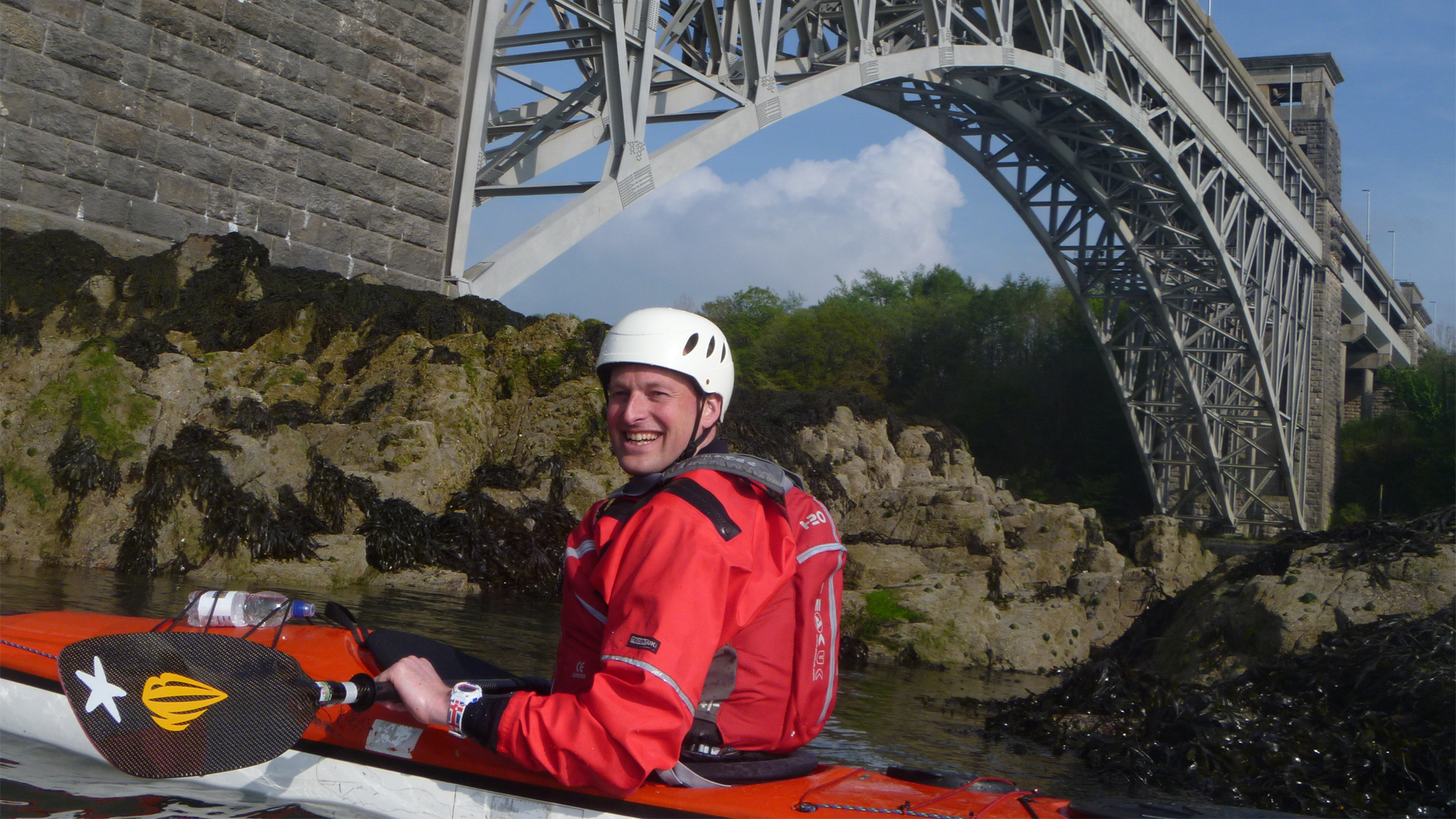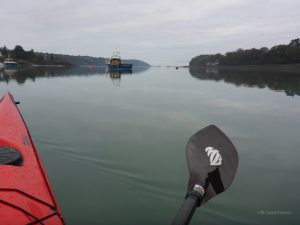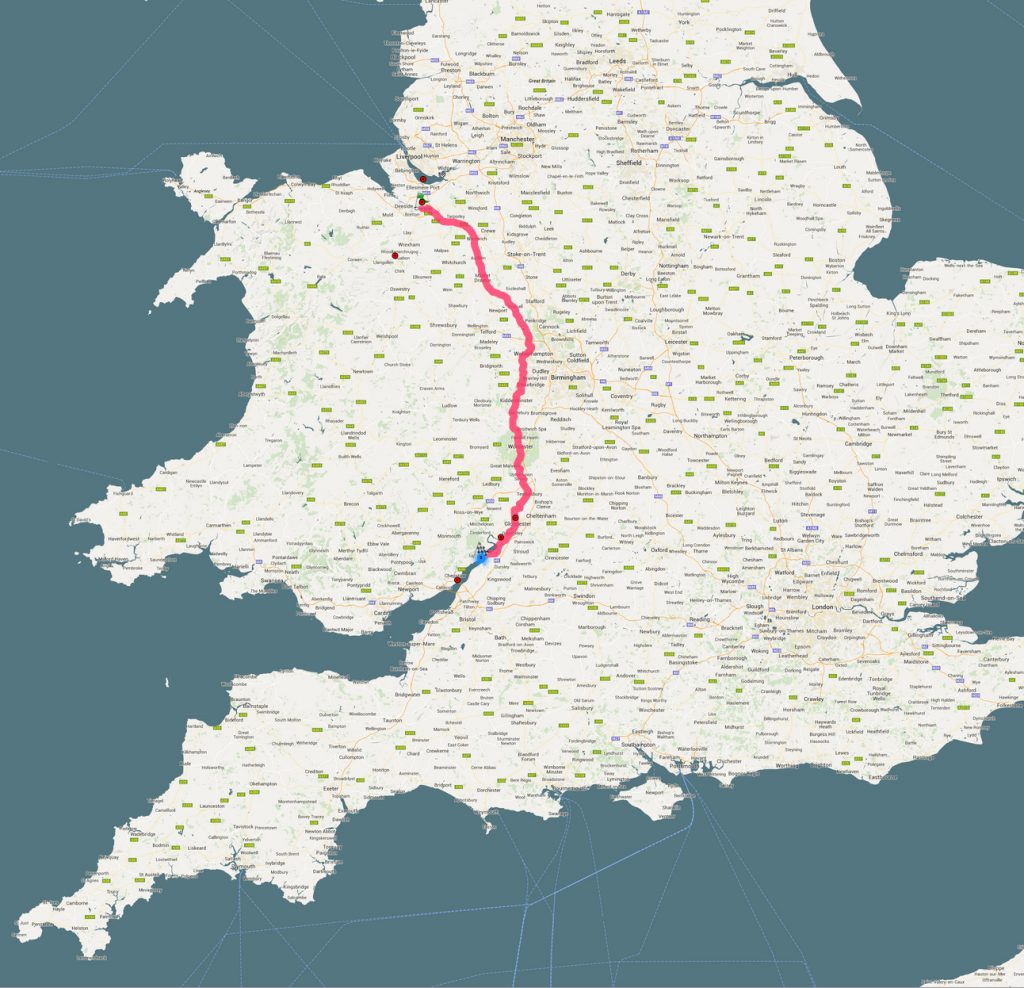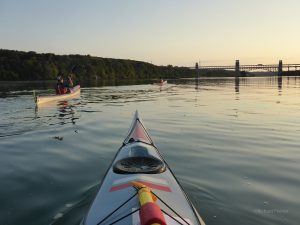By Richard Peevor
–
Out of the winter gloom a few years ago I received a string of emails from a guy who wanted to take up sea kayaking. He’d not paddled one before of course, but he was a sailor (yeah…) – he had been a runner too in the past, his name was Richard, and, oh yeah, he had a heart problem. What could possibly go wrong I thought? He wouldn’t leave me alone though, and so in the end I took him out for a paddle, aiming for a bit of email peace and quiet. A couple of years later he’s a regular in our training sessions; I’ve given him little leeway nor made allowance for his lack of experience, he’s endured the weather and survived ‘big-boy’ sessions, he’s suffered straight-talking and my grumpiness. I can’t put him off… PSK
My Garmin GPS: A love – hate – love relationship. (Getting in to Performance Sea Kayaking)
It’s 05:15 on a Sunday morning when the alarm goes off… Despite struggling to get to sleep last night and probably only sleeping for four hours (thanks to simply going over and over how I am going to go round a red buoy and get back to a slipway) I’m wide awake. I’m into the car and on the road by 05:45, in the dark. I’ve got an excited but nervous feeling in my stomach. All this is just to get on the water early enough to get the ideal tidal window to do the Menai Challenge. We are in a high pressure at the moment, it’s the first weekend of decent weather in ages, with no wind forecast… perfect conditions. To most people this challenge will mean nothing and getting up to do it at silly o’clock on a Sunday, even more of a waste of time; but to me, it means a lot.
A couple of minutes after 08:00 I press the button to stop my Garmin, job done! I’m pretty chuffed with my time, but not 100% satisfied. In a way that’s good, as it’s the drive you need to improve in the future. During the drive home I have that satisfied feeling and a smile on my face, it reminds me of the feelings I had after completing running races and triathlons five or six years ago. The difference is, with these paddling challenges I have a blank canvas of personal bests and I don’t have to compare my achievement (or lack of) to times from that period in my life when I was two stone lighter, a lot fitter and when I had a fully functioning mitral valve in my heart!
And that’s where all of this comes from…
For a week or two in September 2013 I was panicked with worry, I’d gone for a run, felt rubbish, out of breath and not able to run more than about half a mile. I got my stethoscope out of my bag and listened to my chest and heartbeat… Oh f*ck! I heard a heart murmur. Five minutes later I’d written myself off and booked myself in for open heart surgery. Thankfully, the cardiologists knew a bit more than me and after a few stressful weeks of investigations and consultations I found out my mitral regurgitation was mild to moderate and hopefully would improve with some medication. I even took a photo of my first pack of tablets knowing that for the rest of my life I’d be taking pills… oh joy, aged 36!
The first year was tough, not physically, but 100% psychologically. I knew medically I was fine but I was panicking that I’d get worse and no Google search term could tell me how quickly, slowly, or not at all, that my condition would change. The doctor had told me it was good to be fit and the only thing I should avoid was lifting heavy weights. I had many months off running and every time I tried to start again my performance was so shocking to me I couldn’t do more than 3-4 runs before I stopped again. Struggling to run 11 minute miles when 8 minute miles were comfortable previously was a killer… My Garmin wasn’t lying it was telling me the truth: my fitness was atrocious.
Five years earlier I loved my Garmin, I remember running races, not particularly well, but glancing down at my Garmin every few seconds to see I was still on track for a personal best. It didn’t lie then either, it was just a kinder truth than the truth it was telling me in 2013.
After months of inactivity I knew I had to take the cardiologists advice and get off my backside and try to get fitter. I just had to work out how to do it.
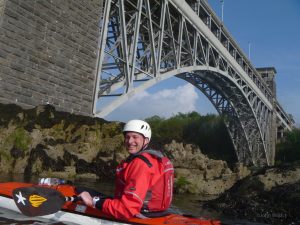 I commute up and down the A55 and I had seen plenty of sea kayaks heading to and from Anglesey. I was intrigued, so I started to look into it. I realised that Anglesey was one of THE places to paddle in the UK; so, during Winter, a good time to think about starting sea kayaking, I decided that’s what I was going to do. I started getting to grips with the local Anglesey Sea Kayaking providers and got myself booked onto one of Phil Clegg’s courses for the Spring, May 2014. I immersed myself into Google searches on paddling and I stumbled across Simon Willis’ website ( www.seakayakpodcasts.com) and I listened to a podcast by John (Willacy) on Performance Sea Kayaking and I wondered, even though I couldn’t paddle, and had never sat in a sea kayak, if this was something I could get into. I found the PSK website (www.performanceseakayaking.com) and I emailed John to enquire about the possibility of some 1-2-1 coaching. After a load of emails back and forth I had my first sit in a sea kayak in April 2014. I paddled John’s old P+H Quest and even though it was a stable boat, I remember how unstable I felt just sitting in it, BUT my eggs were all in this one basket and I was going to give this my all, I needed to psychologically.
I commute up and down the A55 and I had seen plenty of sea kayaks heading to and from Anglesey. I was intrigued, so I started to look into it. I realised that Anglesey was one of THE places to paddle in the UK; so, during Winter, a good time to think about starting sea kayaking, I decided that’s what I was going to do. I started getting to grips with the local Anglesey Sea Kayaking providers and got myself booked onto one of Phil Clegg’s courses for the Spring, May 2014. I immersed myself into Google searches on paddling and I stumbled across Simon Willis’ website ( www.seakayakpodcasts.com) and I listened to a podcast by John (Willacy) on Performance Sea Kayaking and I wondered, even though I couldn’t paddle, and had never sat in a sea kayak, if this was something I could get into. I found the PSK website (www.performanceseakayaking.com) and I emailed John to enquire about the possibility of some 1-2-1 coaching. After a load of emails back and forth I had my first sit in a sea kayak in April 2014. I paddled John’s old P+H Quest and even though it was a stable boat, I remember how unstable I felt just sitting in it, BUT my eggs were all in this one basket and I was going to give this my all, I needed to psychologically.
John knew my motivation, where I was coming from and what I was hoping for. I am still not sure what he made of me in those early days but he was happy to keep coaching me so I was happy with that.
In the Spring of 2014 I had had a few days of coaching with John, Phil Clegg and Barry Shaw, I was enjoying getting out on the water. I was getting good coaching but it was an expensive pastime doing courses knowing that I wasn’t safe getting out on the water without a coach. I had enquired with local clubs but many didn’t have boats, or boats that I could fit into! I’m 6’5” and although not that fat, I couldn’t fit in most boats. I’ve never felt such a freak. I turned up to one club paddle, got fully kitted up and found I couldn’t get in a club boat and had to go home again…. Demoralised to say the least!! I think clubs need to invest in a few boats that prospective members can use to try out paddling prior to taking the expensive plunge into buying a boat, otherwise it’s a huge leap of faith.
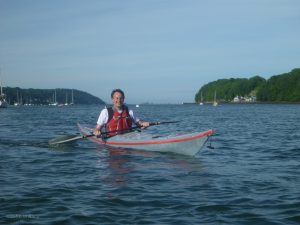 Because I wasn’t getting out paddling enough I decided I needed to buy a boat, it took months to find an appropriate boat but eventually I bought an Explorer HV from Nigel Dennis, even then my troubles weren’t over, his paddle making machine broke… I was potentially on the creek but without the paddle! Luckily Phil Clegg was fab and he gave me a long term loan of a paddle, I was so grateful. After three months waiting I cancelled my paddle order and went to see Lance Mitchell in Chester instead, he made me two paddles and was a nice bloke to boot… things were coming together! After about six months I’d managed to get a set of paddling kit together. If I hadn’t been so motivated to make this succeed, I suspect with all of this hassle I’d have given up.
Because I wasn’t getting out paddling enough I decided I needed to buy a boat, it took months to find an appropriate boat but eventually I bought an Explorer HV from Nigel Dennis, even then my troubles weren’t over, his paddle making machine broke… I was potentially on the creek but without the paddle! Luckily Phil Clegg was fab and he gave me a long term loan of a paddle, I was so grateful. After three months waiting I cancelled my paddle order and went to see Lance Mitchell in Chester instead, he made me two paddles and was a nice bloke to boot… things were coming together! After about six months I’d managed to get a set of paddling kit together. If I hadn’t been so motivated to make this succeed, I suspect with all of this hassle I’d have given up.
During that first Summer of paddling I managed to get out once a week, often just a quick evening paddle but trying to work on skills and getting used to being in a boat as well as just having fun. Looking back through my emails though I can see that my mind was always on the performance side of things. I kept hassling John about the upcoming weather to see if we could do the Menai Challenge on one of our coaching sessions. My first Menai Challenge came on 9th November 2014. John followed me round pointing me in the general direction I needed to go, shouting words of encouragement like, “stop paddling like a girl” and was poised, ready to scoop me up if I fell in. It wasn’t pretty but it was 1hr 11min…. and I’d done it. My first bit of hard exercise in 2 years and that psychological wall had just had the top course of bricks knocked off it. I’d loved it!
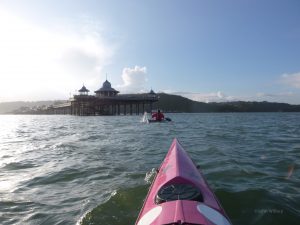 My first goal had been reached, my first season had shown me I enjoyed sea kayaking and I’d got to the point where I could stay in my boat long enough to do a Menai challenge. Over that Winter, as well as continuing to try to develop my paddling, my mind started to think of what my next challenge could be. One of the benefits of Anglesey paddling is that you get to meet the big boys and girls of paddling and it’s a pleasure to chat to so many experienced paddlers who have done so many amazing trips. I work full time and can’t do big trips and I certainly don’t have the paddling skill to do them safely either so I had to think of what I could do as a challenge to myself. My next attempt at getting that psychological wall knocked down…
My first goal had been reached, my first season had shown me I enjoyed sea kayaking and I’d got to the point where I could stay in my boat long enough to do a Menai challenge. Over that Winter, as well as continuing to try to develop my paddling, my mind started to think of what my next challenge could be. One of the benefits of Anglesey paddling is that you get to meet the big boys and girls of paddling and it’s a pleasure to chat to so many experienced paddlers who have done so many amazing trips. I work full time and can’t do big trips and I certainly don’t have the paddling skill to do them safely either so I had to think of what I could do as a challenge to myself. My next attempt at getting that psychological wall knocked down…
I’d seen the route people had done paddling around Wales, I’d read Roger Chandler’s articles and Roger Pyves’ blog of his trip. This was still too big a trip for me but I wondered if I could do the North – South paddle down the inland waterways, this was still a good trip 240 km and I thought it would take me a week. This was going to be relatively safe but would still be an adventure and an achievement for me if I could do it. I planned to raise money for one of my work charities, Jo’s Cervical Cancer Trust. The whole trip went well. I finished in five days, pushing on each day, coping with lugging my boat and kit around the 90 or so locks and finished without any injuries. I also raised just over £3000 so that was amazing.
I was well chuffed. I really felt at this point I was getting back to normal and my heart problem was starting to slip to the back of my mind.
After my Wales trip and being in my second season, I felt like a paddler, not a good one, not an experienced one, but, still a paddler. My plan that started from those December emails was working. I was enjoying exercising again and I was proving to myself that the heart valve abnormality was mainly a psychological, and not a physical barrier to fitness (for the moment anyway).
Now that I am training, my Garmin comes out on the water with me regularly, I’m starting to work out what’s good and what’s not. Unlike running, the road isn’t fixed, it moves as well, so if you are having a bad day you can always blame the water and not your own fitness / skill if the numbers aren’t looking so good.
On a serious note however it makes it quite hard to judge progress because paddling on the same stretch of sea each hour of the day will give you different speeds and heart rates and it makes assessment of overall training progress much harder. When running its relatively easy to look at pace and heart rate, compare it to your perceived effort and you can see if you are getting fitter or if you are having a bad day. Also, if you decide to run a 10K or a half marathon a quick Google search will bring up 12 week training plans, 16 week training plans each telling you when to go hard when to go easy and how far to run each day of the week to almost guarantee you a successful day out at a race. I used to follow these to the letter and reap the reward 3 or 4 months later. It’s a bit different with Performance Sea Kayaking! There are no training plans and no textbooks. Maybe it’s time for a first book John?
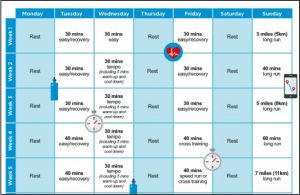 I’m looking forward to 2016, I’m hoping to train regularly and build my fitness. I’m just trying to finalise what this year’s challenges are going to be but it will be something. One thing that’s in the plan is a Taran, – I loved paddling it for my most recent Menai Challenge. It’s a boat that puts a smile on your face! And without trying too hard it gives you that 6th gear.
I’m looking forward to 2016, I’m hoping to train regularly and build my fitness. I’m just trying to finalise what this year’s challenges are going to be but it will be something. One thing that’s in the plan is a Taran, – I loved paddling it for my most recent Menai Challenge. It’s a boat that puts a smile on your face! And without trying too hard it gives you that 6th gear.
The main reason for writing this article is that it will hopefully show that a novice paddler (I’m just starting my third year of paddling) can make a start in Performance Sea Kayaking. It isn’t elitist, the good paddlers will happily chat to the less able paddlers to try to help them on their way. Sea kayaking is a great hobby but if you move those paddles a bit harder/quicker through the water it can also be a good way to increase fitness and add another dimension to your paddling. Challenges are personal and with this sport it’s easy to set yourself an achievable goal.
I’d encourage anyone to have a go.
Richard Peevor
May 2016
